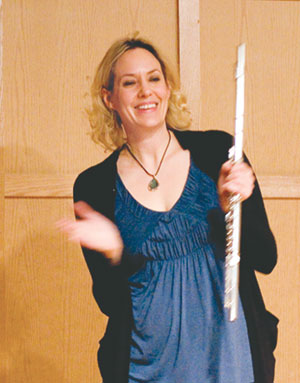 I have never had much of a problem with stage fright even as a child. I would get butterflies, my throat would get dry, and I would sweat, but I always managed to pull off performing with aplomb and applause. I even garnered some fancy blue ribbons from district solo competitions.
I have never had much of a problem with stage fright even as a child. I would get butterflies, my throat would get dry, and I would sweat, but I always managed to pull off performing with aplomb and applause. I even garnered some fancy blue ribbons from district solo competitions.
As I got older and progressed in my studies, however, I started doing more competitions where the stakes were a bit higher: a chance to solo with an orchestra, or a $500 first prize. I began noticing that, although sometimes I played quite well, more often than not I failed to perform at my best, and sometimes just collapsed in a heap of burning rubble (artistically speaking). I didn’t really know what to do to fix the problem and felt helpless and frustrated. In my senior year in high school, my flute teacher loaned me a book that he said helped him improve his golf game.
Despite its science-fiction sounding title, Maxwell Maltz’s Psycho-Cybernetics is about creative visualization and learning to trust in your inherent ability to form and carry out good habits. Professional athletes have used visualization for many years as part of their normal training routine. I devoured the book, did some of the visualization exercises in it, and was delighted that the end result was a stellar performance of the Mozart D Major Concerto by memory with an orchestra in front of a huge audience.
Since then I have worked with sports psychologists and visualization experts and have talked with many colleagues about performing one’s best under pressure. The following are some ideas that may help.
Know the music
It seems obvious, but if you can’t play a piece cleanly in the comfort of your own home, the chances are pretty good that there won’t be a miraculous occurrence that will allow you to suddenly sail through the difficult passages on stage. Practicing scales, etudes, and tone exercises in addition to learning pieces gives you a good base level of skills.
This is similar to what a professional athlete does. For instance, a champion figure skater will spend hours in ballet classes, work with movement coaches, and do cardio and weight training, in addition to the time they spend on the ice. They also spend many hours reviewing video footage of past competitions and analyzing what they did right and what went wrong.
It is also extremely important to know your music more thoroughly than just being able to read it. Flutists are often quick, clever readers: we can zip through fast technical passages with the best of them. Unfortunately, this often comes at the expense of really learning the music as thoroughly as we should in order to do the piece justice.
• Visual – Have a picture of the sheet music in your mind.
• Aural – Be able to play it by ear
• Kinesthetic – The fingerings are in muscle memory.
• Theory/structure – What are the main themes, and where are they throughout the piece? What are the harmonic relationships throughout the piece? What key is it in? Does it change keys? What scales and arpeggios are used at specific points? How does your part relate with the piano or orchestra part? Do you know what the other parts are doing at all times?
• Solfege – Be able to sing what you play.
Most musicians who perform by memory use a synthesis of these. I often trust my kinesthetic sense and let the music take care of itself. However, if there is a tricky technical passage coming up, I briefly focus on that technical element so that I don’t lose control. At the same time I try not to lose the feeling of spontaneity. I also have a visual back-up copy of the music in my head when performing from memory. I don’t refer to it often, but it’s nice to know that it is there.
Performing is Not Practicing
Performing is similar to practicing a difficult piece; it gets easier the more you do it. Perform often, in low-pressure, positive environments before you jump into the big competition. Play for parents and grandparents, friends, in retirement homes, hospitals, or churches. You will have great experiences and positive memories of your performance when you play at a more stressful audition or competition. As you gain confidence, you will feel comfortable taking more artistic and emotional risks. You will also be able to view an audition or competition as simply one more event in your life as a musician, not as the ultimate make or break scenario.
Just Breathe
For some reason, this is the trickiest thing to do when you are nervous. Once you have the ability to control your breathing, however, the other physical and mental distractions associated with performance anxiety seem to fall by the wayside. Deep breathing physically gets you away from the “fight-or-flight” mentality of shallow breathing and muscle tension.
Peter Lloyd, principal flute of the London Symphony for many years, taught me a wonderful four-step breathing exercise. He used to do it on the train – so you can certainly do it away from your normal practice area, perhaps even while lying down at night, or while you are in an exceptionally long line at the grocery store!
Use a second hand on a clock, or a metronome set at quarter = 60.
1. Breathe in for four seconds. (Breathe from your gut, not your upper chest. Think of filling your lungs from the bottom up while keeping your shoulders down and relaxed.)
2. Hold for four seconds.
3. Breathe out for four seconds.
4. Hold for four seconds.
Practice this for fifteen minutes. It may seem pretty simple at first, but you will probably start sweating by minute nine or so. If the exercise is too easy for you, bump up each step to five seconds long, then six seconds, and so forth. One of his students, a very accomplished swimmer, managed to get to 26-seconds.
Another great exercise is to practice performing with an increased heart rate by doing sprints or climbing stairs before playing. They raise the heart rate and simulate a performance situation. Then focus on deep breathing and concentration while you play.
Relaxation exercises teach you how to release tension deliberately when it builds up in your body. The “Progressive Relaxation Exercise” is a example of an exercise that is available on many websites; you can download audio files and hear someone guide you through the exercises. I occasionally use progressive relaxation exercises to help me fall asleep at night!
Practice Creative Visualization
Athletes visualize their ideal performance many days before a competition. Psychologists say it takes about 21 days to successfully break a habit and learn a new one, so start visualizing your concert or audition scenario three weeks before the event.
Some call creative visualization “the theater of the mind.” When you are visualizing, the sky’s the limit: you can infuse musical passages with specific colors, fleeting images, or scenes from your life, whatever emotion or thought jumps out at you when you think about a phrase. The goal is not for the audience to hear or understand the visualization, but that you are completely invested in what you are portraying at a specific moment in time.
A Short Visualization Exercise
Maltz’s premise in Psycho-Cybernetics is that we can program the brain with positive performance results by visualizing the performance before it takes place. See yourself walk on stage, take a bow, and play each piece beautifully, easily, and exactly how you want it to go. Doing this mental exercise creates a sense of confidence and well-being. It also tells your brain that, when you walk on stage to actually play the recital, you won’t be playing it for the first time. You have done it dozens of time before in your imagination.
Try this short exercise. Close your eyes and get comfortable. Sit in a comfortable chair or lie on a bed or sofa. Breathe evenly and deeply.
Go through the performance with as much detail as possible: what does the hall look, feel and sound like? Who is in the audience? How will you enter the stage? What are you wearing? What do the flute keys feel like under your fingers? How do you sound? How does your body feel as you breathe in and out? Most importantly, what emotions are you feeling as you play? What do you want to give to the audience? What feelings and ideas in the music do you want to portray?
Tell yourself that, if someone coughs or you have a slight memory slip or technical mishap, you will just acknowledge it and move on with what you want to present. Distractions happen in performances, and the important thing is to stay focused and simply turn them into a small blip instead of a major earthquake.
Monitor Self-talk
How many times during the day do you find that you are silently berating yourself in your head? Thought patterns are powerful. If you catch yourself doing this on a regular basis, and the things you say are consistently negative, write them down, sentence by sentence. Change each negative into a sentence with a positive outcome. For example: “I am so bad on this phrase – I can never get enough air!” might become, “I play this phrase beautifully when I relax and simply fill up my lungs.”
We form pictures in our heads with words: if you tell yourself not to do something, your brain will still form a mental image of the exact thing you don’t want to do, albeit with a big red psychological X slashed through it. It’s much more effective to tell yourself what you do want, rather than what you don’t want.
Create a Safe Haven
I coach a wonderful principal flutist who plays with a semi-professional orchestra on a regular basis, and she used this technique with great success when she was invited to perform a concerto with her orchestra. In addition to the creative visualization exercises, she wanted a little extra insurance in case performance jitters suddenly hit. So when she was in a relaxed, comfortable state of mind, she visualized the most calming, serene, safe place she could think of.
(This can be a place that is familiar to you, or something created in your imagination.) She then anchored that thought with a deliberate physical action. This action is something you would normally not do in the course of your playing or daily life, such as touching your thumb to your middle finger lightly. After a few weeks of practice, she could easily elicit the feeling of being in her safe place whenever she did the action. She used this technique on stage with great success, and it helped her give a stellar performance.
Relate to the Audience
Get rid of the me-vs.-them mentality, which is essentially your ego trying to protect itself. The more consumed we get with ourselves and what we are going through, the more distance we put between ourselves and the audience. We end up feeling more isolated and less able to share a musical experience, and the audience can sense this. Focus on the music, what you’re trying to say with the music, and what you can give to people.
We learn skills like brushing our teeth and tying our shoes by practice and trial and error. We forget the failures and learn from the successful attempts until the skill becomes a habit. We learn music and how to perform on stage with ease and grace the same way. We must suspend judgment of our failures and see them as simply pieces of information in the learning process. That outlook allows us to learn from successful attempts. Problems arise not when we err, but when we pass judgment on ourselves for not being perfect all the time.
I have many humorous recollections of angst-filled competition days as a high school and college student. I viewed the judges very much as being out to get me, ready to pounce on every little mistake I made. Naturally, my playing very often reflected this. My opinion of judges changed dramatically when I became one myself and realized a couple of important points. They want the competitors to do their best because they have all have been there too, and the judges are only human. Sometimes their comments are terse or not specific, but after listening to three hours of flutists, they get tired. Most important, each judge has his own bias about what is the best flute playing.
A number of years ago, when I first started judging, I judged a high school flute competition. There were two students in the finals for their age group, and the panel of three judges was to assign first and second place winners. The first student, in my opinion, was better. Although her tone lacked focus, she was much more musically expressive. The second student had a beautiful sound but not much in the way of musical expression. I figured it was a slam dunk; of course we should reward the most musical performance.
However, one of the other judges was very adamant about awarding first place to the student with the beautiful tone. She thought the foundation for flute playing was a gorgeous sound, and if you don’t have that, what do you have? After much debate we awarded first place to the beautiful flute tone student.
A few years later I was chatting with a college flute professor. We were discussing various former students, and the college teacher recalled a student who had been frustrating to teach because she had a beautiful sound that had garnered much praise. However, it had been incredibly difficult to elicit musical expression from that student through all four years of college as a music major. That former college student happened to be the judge I had run into on the flute competition panel.
She was not an incompetent judge, she merely valued an aspect of playing that she had received praise for and viewed as being the most important for successful flutists. While most competition judges may not be that overt, none are purely unbiased in a medium that is so subjective. So, view judges’ comments accordingly. The common-sense flip side, of course, is that if every judge is making the same types of comments, you might want to heed their collective advice.
Trust in yourself, and trust that the music will take care of itself. One of my favorite expressions is “Leap, and the net will appear.” There is something delightfully freeing (and very ironic) about letting go and trusting that the habits you’ve worked hard to acquire will be there naturally, in this place and in this time.
Find balance: When you’re in the practice room, you obviously do need to be detailed and picky with what you’re doing and analyze what’s wrong so you can correct it. If you do that during a performance, your performance will seem stifled and self-conscious. Don’t critique yourself when performing – just play. This is not to say that you don’t focus on any technical aspects or are space out when you are on stage; rather, it’s a delicate dance between mental focus on certain parts of the music while allowing your creativity and built-up habits to flow through your performance.
For example, when there is a tricky technical passage coming up, I might direct my focus to have clean fingers between the D and the E, but my overall thought is always going to be more global in scope: what do I want to get across musically.
Cultivate gratitude. To be truly comfortable sharing your music with others, you have to feel, on some level, that you have been given a beautiful gift, and that you can afford to give it away without the knowledge of what you will get in return. As musicians we often work in the trenches, trying to perfect this or that thing, comparing ourselves to whomever, or wishing this or that were different. We simply forget to be grateful for the grace to learn and grow, grateful for the ability to blow into a shiny metal tube and make others feel something. Grateful for a world with music.
Resources
Maxwell Maltz: Psycho-Cybernetics
Robert Caldwell: Performer Prepares
Don Greene: Fight Your Fear and Win: 7 Skills for Performing Your Best Under Pressure – At Work, In Sports, On Stage
Barry Green: The Inner Game of Music
Janet Esposito: In the Spotlight: Overcome Your Fear of Public Speaking and Performing
Linda Chatterton: It Sounded Better at Home! (linda@lindachatterton.com for publication notification).






